HOMININS IN CHINA
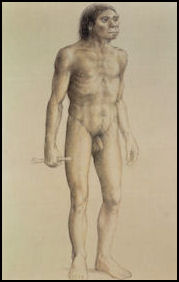
Homo erectus Evidence has been found of early paleolithic hominins living in China more than 2 million years ago. The remains of Homo erectus (Peking Man)), found southwest of Beijing in 1927, date from around 700,000 years ago. Hominins are early forms of humans. The stone tools and fossils linked to Homo erectus found in north and central China are the earliest discovered protohuman remains in northeast Asia. Some of the tools date to more than 1.3 million years ago. [Source: Columbia Encyclopedia, 6th ed., Columbia University Press]
Until recently scientists believed that man evolved in Africa and didn't leave that continent until 2 million years ago and the first hominin to arrive in Asia and Europe was Homo erectus, a species which includes the famous Java Man and Peking Man. Now scientists working in China and elsewhere in Asia are challenging these theories. 1.8 million-year-old hominin fossils in Georgia and 1.6-million-year-old Java Man Homo erectus fossils in Indonesia indicate that Homo erectus may have migrated into Asia as early as 2 million years ago — and then migrated across the continent very quickly.
The discovery of 2.1 million-year-old tools in China appears to indicate the first hominins left Africa before 2 million years ago or perhaps a hominid species more primitive than Homo erectus may have evolved in China before that time. Two sites in Asia — Jianshi in Hubei province and and Tham Khuyen in Lang Son province, Vietnam — yielded teeth labelled variously as Australopithecus, H. erectus and Meganthropus. Scientists now believe the teeth most likely to an ape. A 2009 paper identifies a tooth from Sanhe Cave (Chongzuo, Guangxi province, China) — said to have come from a hominin — as belonging to an unidentified ape.
The ancestors of humans are called both hominins and hominids. Hominids include all modern and extinct Great Apes ( modern humans, chimpanzees, gorillas and orangutans and all their immediate ancestors). Hominins include modern humans, extinct human species and all our immediate ancestors (including Australopithecus and members of the genera Homo such as homo erectus and homo habalis). [Source: Australian Museum]
Many artifacts in China are dated using paleomagnetic dating — a method that dates objects by measuring the periodic reversals of the north and south magnetic poles, which have occurred at known times and rates — and the new method of electron spin resonance. The most reliable and accurate way to date very old fossils is to date the volcanic deposits they are found in. China however lacks volcanic deposits and thus fossils found there are more difficult to date than those found in Africa and Indonesia, where volcanic deposits are abundant. The oldest artifacts found in China tend to be tools rather than bones and fossils from hominins, which make its hard to figure out who used and produced the tools and artifacts found.
See Separate Articles: UNUSUAL HUMAN-LIKE FOSSILS FROM CHINA FROM 300,000 TO 100,000 YEARS AGO factsanddetails.com ; EARLIEST MODERN HUMANS IN CHINA (100,000 TO 20,000 YEARS AGO) factsanddetails.com GENETIC ORIGIN OF THE CHINESE AND THEIR LINKS TO TIBETANS, TURKS, MONGOLS AND AFRICANS factsanddetails.com
RECOMMENDED BOOKS:
“Ancestral DNA, Human Origins, and Migrations” by Rene J. Herrera (2018) Amazon.com;
“Asian Paleoanthropology: From Africa to China and Beyond” (Vertebrate Paleobiology and Paleoanthropology) by Christopher J. Norton and David R. Braun Amazon.com;
“Emergence and Diversity of Modern Human Behavior in Paleolithic Asia” by Yousuke Kaifu, Masami Izuho, et al. Amazon.com;
“Paleoanthropology and Paleolithic Archaeology in the People's Republic of China” by Wu Rukang, John W Olsen Amazon.com;
“In search of Homo erectus: a Prehistoric Investigation: The humans who lived two million years before the Neanderthals” by Christopher Seddon (2017) Amazon.com;
“Peking Man” Amazon.com;
“Java Man : How Two Geologists' Dramatic Discoveries Changed Our Understanding of the Evolutionary Path to Modern Humans” by Roger Lewin , Garniss H. Curtis, et al. Amazon.com;
“Liangzhu Culture” by Bin Liu, Ling Qin, et al. Amazon.com;
“A Brief History of Ancient China” by Edward L Shaughnessy Amazon.com
“Processes in Human Evolution: The journey from early hominins to Neanderthals and modern humans” by Francisco J. Ayala, Camilo J. Cela-Conde Amazon.com;
“Evolution: The Human Story” by Alice Roberts (2018) Amazon.com;
“Perspectives on Our Evolution from World Experts” edited by Sergio Almécija (2023) Amazon.com;
“Discovering Us: Fifty Great Discoveries in Human Origins” By Evan Hadingham (2021) Amazon.com;
“Who We Are and How We Got Here: Ancient DNA and the New Science of the Human Past” by David Reich (2019) Amazon.com;
“Stone Tools in Human Evolution”
by John J. Shea (2016) Amazon.com;
“Our Human Story: Where We Come From and How We Evolved” By Louise Humphrey and Chris Stringer, (2018) Amazon.com;
“Lone Survivors: How We Came to Be the Only Humans on Earth” by Chris Stringer (2013) Amazon.com;
“Almost Human: The Astonishing Tale of Homo Naledi and the Discovery That Changed Our Human Story” by Lee Berger, John Hawks, et al. Amazon.com;
“An Introduction to Human Evolutionary Anatomy” by Leslie Aiello and Christopher Dean (1990) Amazon.com;
“Basics in Human Evolution” by Michael P Muehlenbein (Editor) (2015) Amazon.com;
“Sapiens: A Brief History of Humankind” by Yuval Noah Harari (2011) Amazon.com;
Homo Erectus in China
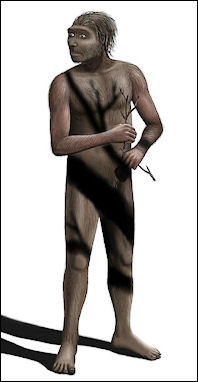
Homo erectus
Homo erectus lived 2 million years to 110,000 years ago. He had a considerably larger brain than his predecessor Homo habilis, fashioned more advanced tools (double-edged, teardrop-shaped "hand axes" and "cleavers" ) and controlled fire (based on the discovery of charcoal with erectus fossils). Better foraging and hunting skills improved his ability to exploit his environment.
The dating of Java Man Homo erectus bones to around 1.6 million years ago suggests that Homo erectus traveled through China or nearby Southeast Asia to reach Java in Indonesia. Russell Ciochon and Roy Larick wrote in Natural History magazine, “There are a half dozen sites in China dating (more or less convincingly) to between 1.8 million and 800,000 years ago.” Some have stone tools. Others have human-like bones. There is some debate as to whether these bones belong to hominins or apes.
Paul Rincon of the BBC wrote: Comparisons with other sites show that Homo erectus survived successive warm and cold periods in northern Asia. Researchers Russell Ciochon and E Arthur Bettis III, from the University of Iowa, US, believe these climatic cycles may have caused the expansion of open habitats, such as grasslands and steppe. These environments would have been rich in mammals that could have been hunted or scavenged by early humans. [Source: Paul Rincon, BBC, March 11, 2009]
“Recent revised dates for other hominin occupation sites in North-East Asia show that human habitation of the region began about 1.3 million years ago.” Chinese “fossils are a vital component of the Out of Africa migration theory, which proposes that Homo erectus first appeared in Africa around two million years ago before spreading north and east (modern humans, Homo sapiens, would follow much later and supplant all other Homo species). Evidence of the first dispersal comes from the site of Dmanisi in Georgia, where numerous homini fossils dating to 1.75 million years ago have been unearthed. Finds from Java suggest early humans reached South-East Asia by 1.6 million years ago. [Source: Paul Rincon, BBC, March 11, 2009 ^|^]
See Separate Article: HOMO ERECTUS IN CHINA: SITES, FOSSILS, IMPLICATIONS factsanddetails.com ; HOMO ERECTUS: factsanddetails.com
Peking Man
Peking Man (Sinanthropus pekinensis) was not a single individual, but a species of Homo erectus who were very similar to modern humans, having a large brain, and similar skull and bone sizes, but who had heavy brows and large, chinless jaws. They lived between 750,000 and 200,000 years ago.
"Peking Man" refers to a collection of six complete or nearly complete skulls, 14 cranial fragments, six facial fragments, 15 jawbones, 157 teeth, one collarbone, three upper arms, one wrist, seven thighbones, and one shinbone found in caves and a quarry in Zhoukoudian outside of Peking (Beijing). It is believed the remains came from 40 individuals of both sexes. Both Peking Man and Java Man have been categorized as members of the hominin species Homo erectus.
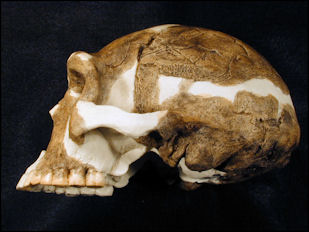 The Peking Man bones are the largest collection of hominin bones ever found at one site and were the first evidence that early man reached China. It was first thought the bones were between 200,000 and 300,000 years old. Now it is believed that they are 400,000 to 780,000 years old based on dating the sediments in which the fossils were found. No chemical tests or research were ever done on the bones before they mysteriously disappeared at the beginning of World War II.
The Peking Man bones are the largest collection of hominin bones ever found at one site and were the first evidence that early man reached China. It was first thought the bones were between 200,000 and 300,000 years old. Now it is believed that they are 400,000 to 780,000 years old based on dating the sediments in which the fossils were found. No chemical tests or research were ever done on the bones before they mysteriously disappeared at the beginning of World War II.
Paul Rincon of the BBC wrote: “The cave system of Zhoukoudian, near Beijing, is one of the most important Palaeolithic sites in the world. Between 1921 and 1966, archaeologists working at the site unearthed tens of thousands of stone tools and hundreds of fragmentary remains from about 40 early humans. Palaeontologists later assigned these members of the human lineage to the species Homo erectus. The pre-war Peking Man fossils vanished in 1941 whilst being transported to the US for safekeeping. Luckily, the palaeontologist Franz Weidenreich had made casts for researchers to study.” [Source: Paul Rincon, BBC, March 11, 2009]
See Separate Article PEKING MAN: FIRE, DISCOVERY AND DISAPPEARANCE factsanddetails.com
Very Old Hominin Sites from China
There are a lot of very old hominin sites in China and a lot of controversy surrounding them and the interpretations that have been drawn from them. The following is a sample of some of these. The dating and conclusions made from some of the sites are still being debated by paleontologists.
Stones tools found in Renzidong (Reni Cave) in Anhui Province in eastern China suggest that Homo erectus may have established itself in China 2.25 million years ago. Teeth and tools found in Chinese province of Yunnan once thought to be 700,000 year old were redated and found to be 1.8 millions year old through paleomagnetic analysis. Stone tools found in the Nihewan Basin of north-central China indicate that humans lived in northern China as early as 1.36 million years ago.
A skull found in Yunxian, China, believed to be at least 1 million years old, has browridges like Homo erectus specimens found in Java has the facial features that are more similar to younger skulls found in Europe. "This mix of characteristics tells us that there was more diversity within Homo erectus than we had thought," one scientist told National Geographic. Other scientist believe that skull is not from Homo erectus at all but from a species called Homo heidelbergensis that may have given birth to modern humans and Neanderthals.
Out of Africa Theory
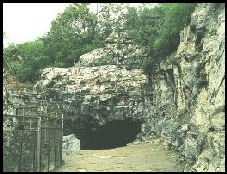
Peking Man cave The oldest known evidence of hominins outside of Africa come from the site of Dmanisi in the Republic of Georgia, one of the most prolific fossil human sites in recent years. The age of the Dmanisi fossils is about 1.85 to 1.75 million years old. [Source: Human Origins Initiative, Smithsonian Institution, May 4, 2016 /]
Jane Qiu wrote in Nature: “In this standard view of human evolution, H. erectus first evolved there more than 2 million years ago (see 'Two routes for human evolution'). Then, some time before 600,000 years ago, it gave rise to a new species: Homo heidelbergensis, the oldest remains of which have been found in Ethiopia. About 400,000 years ago, some members of H. heidelbergensis left Africa and split into two branches: one ventured into the Middle East and Europe, where it evolved into Neanderthals; the other went east, where members became Denisovans — a group first discovered in Siberia in 2010. The remaining population of H. heidelbergensis in Africa eventually evolved into our own species, H. sapiens, about 200,000 years ago. Then these early humans expanded their range to Eurasia 60,000 years ago, where they replaced local hominins with a minuscule amount of interbreeding. [Source: Jane Qiu, Nature magazine, July 13, 2016 |:|]
“A hallmark of H. heidelbergensis — the potential common ancestor of Neanderthals, Denisovans and modern humans — is that individuals have a mixture of primitive and modern features. Like more archaic lineages, H. heidelbergensis has a massive brow ridge and no chin. But it also resembles H. sapiens, with its smaller teeth and bigger braincase. Most researchers have viewed H. heidelbergensis — or something similar — as a transitional form between H. erectus and H. sapiens.” |:|
See Separate Articles: HOMO ERECTUS AND OUT OF AFRICA THEORY factsanddetails.com; OUT OF AFRICA THEORY AND THE MIGRATION(S) OF EARLY MODERN HUMANS factsanddetails.com
Asia, China and the Out of Africa Theory

Homo erectus in Asia
According to the Smithsonian: “Comparing the Georgian and Chinese dates, the evidence from the Nihewan and Yuanmou regions is consistent with the spread of early hominin populations beyond Africa into the Caucasus region and into East Asia between roughly 2 million and 1.7 million years ago. By 1.66 million years ago, early humans of the genus Homo who reached eastern Asia were able to disperse over a wide area that extended from at least 40̊N (Nihewan basin) to 7̊S (Java, Indonesia), across a habitat range from temperate grassland to tropical woodland and possibly forest. [Source: Human Origins Initiative, Smithsonian Institution, May 4, 2016 /]
“Which species was the first to spread beyond Africa? The Dmanisi fossil humans are widely considered to represent Homo erectus, although skeletal remains suggest that the population at Dmanisi was smaller in stature than East African H. erectus at a broadly similar time. The Yuanmou fossil teeth are very similar to those of the 1.6-million-year-old Turkana boy skeleton from West Turkana, Kenya, usually assigned to H. erectus. The earliest fossils from Java, Indonesia, are typically assigned to H. erectus, and are reliably dated to 1.66 million years old. (A dated layer of 1.8 million years old reported in 1994 comes from about 20 meters beneath the level of the fossil find; this means that the fossil – the Mojokerto child cranium – is younger than the dated layer.)
“The evidence point to Homo erectus as the first. In fact, the relatively longer legs of this species than in earlier hominins may also signal this is species was the first human ancestor capable of ranging over a wide geographic area. However, the oldest Indonesian fossils discovered so far are not complete enough to definitively assign to H. erectus. The Yuanmou teeth are not by themselves sufficient to say they represent H. erectus. Finally, the ‘hobbit’ H. floresiensis is an enigma as to whether its direct ancestor was H. erectus or an earlier species of the genus Homo. The case is still open, then, about which species was the first to reach East Asia. /
“The dispersal to East Asia, nonetheless, culminated in the ability of hominins to adapt to a wide variety of environments and, eventually, H. erectus was able to persist in this part of the world for more than 1 million years prior to the arrival of H. sapiens. The dating work in China is led by Dr. Zhu Rixiang of the Institute of Geology and Geophysics, Beijing. The paleoanthropological part of the project is led by Dr. Rick Potts. Excavations in the Nihewan basin are led by Prof. Xie Fei of the Hebei Province Institute of Cultural Relics, Shijiazhuang.
Taking a New Look Human Evolution in Asia and China
Jane Qiu wrote in Nature: “ “Many Western scientists tend to see Asian fossils and artefacts through the prism of what was happening in Africa and Europe,” says Wu. Those other continents have historically drawn more attention in studies of human evolution because of the antiquity of fossil finds there, and because they are closer to major palaeoanthropology research institutions, he says. “But it's increasingly clear that many Asian materials cannot fit into the traditional narrative of human evolution.” Chris Stringer, a palaeoanthropologist at the Natural History Museum in London, agrees. “Asia has been a forgotten continent,” he says. “Its role in human evolution may have been largely under-appreciated.”[Source: Jane Qiu, Nature magazine, July 13, 2016 |:|]

One theory of dispersal routes out of Africa
Despite the different interpretations of the Chinese fossil record, everybody agrees that the evolutionary tale in Asia is much more interesting than people appreciated before. But the details remain fuzzy, because so few researchers have excavated in Asia. When they have, the results have been startling. In 2003, a dig on Flores island in Indonesia turned up a diminutive hominin, which researchers named Homo floresiensis and dubbed the hobbit. With its odd assortment of features, the creature still provokes debate about whether it is a dwarfed form of H. erectus or some more primitive lineage that made it all the way from Africa to southeast Asia and lived until as recently as 60,000 years ago. Last month, more surprises emerged from Flores, where researchers found the remains of a hobbit-like hominin in rocks about 700,000 years old. |:|
“Recovering more fossils from all parts of Asia will clearly help to fill in the gaps. Many palaeoanthropologists also call for better access to existing materials. Most Chinese fossils — including some of the finest specimens, such as the Yunxian and Dali skulls — are accessible only to a handful of Chinese palaeontologists and their collaborators. “To make them available for general studies, with replicas or CT scans, would be fantastic,” says Stringer. Moreover, fossil sites should be dated much more rigorously, preferably by multiple methods, researchers say. But all agree that Asia — the largest continent on Earth — has a lot more to offer in terms of unravelling the human story. “The center of gravity,” says Petraglia, “is shifting eastward.”
Good Evidence of Hominins in China 2.1 Million Years Ago
Stone tools found in China’s Loess Plateau dated to 2.1 million years ago. were touted by scientists in 2018 as possibly the oldest evidence of human life outside Africa. The Guardian reported: “The remains of crudely fashioned stone tools unearthed in China suggest human ancestors were in Asia 2.1 million years ago, more than 200,000 years earlier than previously thought. If correctly dated, the find means that hominins left Africa earlier than archaeologists have been able to demonstrate thus far, a team reported in the scientific journal Nature. “Our discovery means that it is necessary now to reconsider the timing of when early humans left Africa,” said study co-author Robin Dennell of Exeter University in England. [Source: Agence France-Presse, The Guardian, July 11, 2018]

Another theory on dispersal of modern man in Asia
“Previously, the oldest evidence for hominins in Asia came from Georgia in the form of fossilised skeleton bits and artefacts dated to between 1.77 million and 1.85 million years ago. There have been other, unproven, claims of even older fossil discoveries, the study authors said.
“The latest find of 96 stone tools, was extracted from 17 layers of sediment in the southern Chinese Loess plateau. Dennell and a team used a field of science known as “palaeomagnetism” to date the sediment layers. These form when dust or mud settles before being capped by another new soil coat. Any artefact found within a layer would be the same age as the soil around it. Dennell and a team measured the magnetic properties of minerals in the soil layers to determine when they were deposited. This dated the tools, of a type known to have been manufactured by Homo species in Africa since at least 3.3m years ago.
“The paper offers strong evidence for a hominin presence in Asia further back than we thought, Dennell said. “There may be older evidence in places like India and Pakistan, but so far ... the evidence is not strong enough to convince most of the research community,” he said. “With this type of claim, for an early human presence
Longgupo Cave Remains: Homo erectus? An Earlier Species? An Ape?
In 1986, Chinese paleontologists working at Longgupo (Dragon Hill) caves on the Yangtze River in Sichuan province found part of a tiny, lower jaw with an upper incisor tooth, two other teeth and two fist-size stone tools dated by three techniques to be 1.8 to 2 million years old. The fossils resemble homo habilis, a hominin that first appeared in Africa 2.5 million years ago. Some scientists believed the fossils come from an hominin older than Homo erectus. Critics said they come from an ape. It is difficult to tell for sure without more remains. Stones tools linked the bones to hominins. The Longgupo cave fossils were dated using paleomagnetic dating.
University of Iowa paleontologist Russel Ciochon initially theorized that a species similar to homo habilis left Africa two million years ago and moved into Asia, evolved into Homo erectus, and returned to Africa. He told Newsweek magazine, if the dating holds up "these fossils will be older than any other human remains in China, and the tools will be the oldest artifacts in Asia." The fossils come from a hominin that "wasn't Homo habilis, and it wasn't Homo erectus, but some other pre-erectus species of Homo. Right before 2 million years ago Homo spread out of Africa." Many other paleontologists had problems with this theory.
The Longgupo Cave remains became known as "Wushan Man". They were found in 1985 in Longgupo (literally "Dragon Bone Slope") near Zhenlongping Village, Miaoyu Town of Wushan County, Chongqing in the Three Gorges area of China 20 kilometers (12 miles) south of the Yangtze River. Fossils were discovered at the site in 1984 and then initially excavated by a team of Chinese scientists, led by Huang Wanpo of the Institute of Vertebrate Paleontology and Paleoanthropology in Beijing and the Chongqing National Museum (Sichuan Province) from 1985 to until 1988. The deposits on the cave floor are over 22 meters deep, with the 10 meters containing fossils overlain by 12 meters that do not. [Source: Wikipedia +]
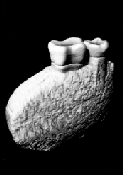
Longgupo
jaw fossil In 1986, three fore-teeth and a left mandible with two molars were unearthed together with the animal fossils including teeth from an extinct type of large ape Gigantopithecus and an extinct pygmy giant panda Ailuropoda microta. Excavations carried between 1997 and 1999 and then between 2003 and 2006 have found additional stone tools and animal fossils including remains of 120 species of vertebrates, of which 116 are mammals. This suggests the fossils existed originally in a subtropical forest environment. +
The jaw and molars found at Lonngupo are now believed to be the be remains of an extinct ape not a subspecies of Homo erectus. In 2009, Ciochon admitted as such. In an article published in Nature, Ciochon wrote: “ For many years, I used Longgupo to promote this pre-erectus origin for H. erectus finds in Asia. But now, in light of new evidence from across southeast Asia and after a decade of my own field research in Java, I have changed my mind. Not everyone may agree; such classifications are always open to interpretation. But I am now convinced that the Longgupo fossil and others like it do not represent a pre-erectus human, but rather one or more mystery apes indigenous to southeast Asia's Pleistocene primal forest. In contrast, H. erectus arrived in Asia about 1.6 million years ago, but steered clear of the forest in pursuit of grassland game. There was no pre-erectus species in southeast Asia after all.[Source: Russell L. Ciochon, Nature, August 2009. This Essay is based on a contribution to the book Out of Africa I: Who, When and Where? (eds, Fleagle, J. G. et al. Springer, 2009) +++]
“In resolving the mystery, two other Asian sites come to mind: Jianshi (Hubei province, China) and Tham Khuyen (Lang Son province, Vietnam). At both sites, teeth labelled variously as Australopithecus, H. erectus and Meganthropus are most likely to be the mystery ape instead. Others have come to similar conclusions7; a 2009 paper identifies a tooth from Sanhe Cave (Chongzuo, Guangxi province, China) as belonging to an unidentified ape8.” +++
2.25 Million-Year-Old Homo erectus Tools in China?
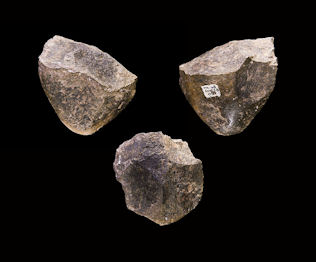
1.7 million years old tools from
Konso-Gardula, Ethiopia
In 2000, Russell Ciochon announced he and other scientists found stone tools among the remains of animals they believed were used by early Homo erectus 2.25 million years ago for butchering. Ciochon and Roy Larick wrote in Natural History magazine, “The ancient fossil site of Renzidong (Renzi Cave) in Anhui Province, eastern China, is yielding animal bones and possible stone tools showing that Homo erectus may have established itself here 2.25 million years ago, more than 400,000 years earlier than previously thought. Renzidong appears to be the oldest among a growing number of sites suggesting great antiquity for hominins (humans and close ancestors) in East Asia. The site, a large fissure, is also fueling a debate on the origins of our genus Homo, with some Chinese scientists proposing an evolution of H. erectus in China parallel to that already observed in Africa. [Source: Russell Ciochon and Roy Larick. Natural History magazine, January/February 2000 +++]
“Renzidong was discovered in a Fangshang County cliff face as workers were quarrying surrounding limestone. Digging for two years now, excavation leader Jin Changzhu of Beijing's Institute for Vertebrate Paleontology and Paleoanthropology and Han Ligang and Zheng Longting of Hefei, Anhui Province, have found some 3,000 bones of animals that had fallen into the fissure. Among nearly 60 species represented, the elephant-like Sinomastodon, an ancient tapir, and the monkey Procynocephalus show that Renzidong was open briefly between 2.5 and 2 million years ago. +++
“But the most exciting evidence is archaeological: about 50 stones and bones fractured to make flakes and scrapers. Early hominins apparently descended into the fissure to butcher the animals that fell in. The problem is that their technology in East Asia was simple; archaeologists frequently have trouble distinguishing real knapped tools from similar objects splintered by natural forces. Moreover, fissure infills never preserve the kind of evidence of habitation we know so well from contemporary sites in East Africa, such as at Tanzania's Olduvai Gorge. But the 1999 campaign began to show something different. The skeletons of a mastodon and a tapir, both victims of falls, were found together in the dig's lower levels. The mastodon bones lie piled along one wall, while the tapir remains seem to have been laid out for butchering; tools were found scattered about. Under this stratum there appears to be a level of Procynocephalus skeletons. This primate, like H. erectus, preferred open environments. Fossils of H. erectus and similar monkeys are often found together at Asian and East African sites.” +++
2.25 Million-Year-Old Tools Show Homo erectus Evolved in Asia?
Russell Ciochon and Roy Larick wrote in Natural History magazine, “Both sides of the culturally charged hominin-emergence debate point to the effect of plate tectonics in climate change. Between 9 and 4 million years ago, the convergence of the Indian and Eurasian continental plates gave rise to the Tibet Plateau, which caused the climates from East Africa to East Asia to become more seasonal and arid. Western scientists believe that these events triggered forest-dwelling apes in equatorial Africa to beget open-dwelling hominins. But Chinese scientists use the tectonic evidence to suggest a parallel hominin emergence in East Asia. In their view, a ten-million-year-old forest ape was the putative ancestor of H. erectus, orangutans, and the extinct Gigantopithecus, the largest ape that ever lived. With Longgupo's primitive teeth and Renzidong's ancient stone tools, the Asian hypothesis is gaining (mostly Chinese) converts. [Source: Russell Ciochon and Roy Larick. Natural History magazine, January/February 2000 +++]
“Whether one favors African or Asian origins, early hominins were ferociously migratory, and this led to the worldwide diaspora of our species, H. sapiens. Early humans repeatedly passed between Africa and Asia, and their movements correspond to those of other large mammals, including carnivores — early Homo and the dagger-toothed cat Megantereon, the remains of which have been found at Renzidong, could have been such traveling companions. +++
“Are the Renzidong tools real? Do the half dozen other Chinese sites reveal the earliest colony of dispersing African hominins — or do they constitute the heartland of the genus Homo? While the Chinese sites pose interpretive problems, the Asian hypothesis for the origin of Homo has energized Chinese scientists and loosed important funding from the Chinese Academy of Sciences and other Beijing-based government agencies.” +++
Chinese Scientists Find 2-Million-Year-Old 'Playground' of Ancient Toys

Peking Man stone scraper
In March 2015, Chinese scientists announced they discovered several hundred objects they described as toys dated to be roughly two million years. Washington University Anthropology News reported: “Archaeologists found more than 700 stone artifacts in the Nihewan basin of China's Hebei province. The archaeologists believe the site was once home to a small "playground" of sorts, The South China Morning Post reports, because it didn't contain animal remains or large stone tools, which would be typical for a habitat site, but not a children's play area. [Source: Meghan DeMaria, Washington University Anthropology News, March 27, 2015 /*/]
“The archaeologists say the artifacts were small and most likely carved by women and children. "This is an amazing discovery," Wei Qi, a paleoanthropologist who is leading the research at the site, told The South China Morning Post. "The site is a treasure chamber that may hold some useful clues to answer a lot of important questions, from the social structure of the early hominins to whether, when, and how they arrived in Asia all the way from Africa." Scientists generally accept that human ancestors migrated out of Africa 1.8 million years ago, but if the site's artifacts predate that figure, it could mean they left earlier or evolved completely independently.” /*/
Image Sources: All Posters com; Longgupo jaw fossil, Wikipedia; Wikimedia Commons
Text Sources: Nature, Library of Congress; New York Times; Washington Post; Los Angeles Times; China National Tourist Office (CNTO); Xinhua; China.org; China Daily; Japan News; Times of London; National Geographic; The New Yorker; Time; Newsweek; Reuters; Associated Press; Lonely Planet Guides; Compton’s Encyclopedia; Smithsonian magazine; The Guardian; Yomiuri Shimbun; AFP; Wikipedia; BBC. Many sources are cited at the end of the facts for which they are used.
Last updated April 2024
